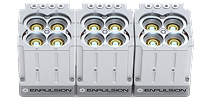Informing FEEP Thruster Design Utilizing the Flight Heritage from 194 Thrusters in LEO and GEO
Abstract:
Since 2018, 185 ENPULSION NANO propulsion systems, as well as 2 ENPULSION MICRO R3 and 7 NANO AR3 system have been deployed in orbit on 79 different spacecraft. These missions included a variety of different satellite bus sizes ranging from 3U Cubesats to >100kg buses, and different orbits in LEO and GEO, providing an abundance of on-orbit data for statistical analysis. Hundreds of heritage NANO systems have been acceptance tested and delivered to customers. This large-scale industrialization and flight heritage allows for a holistic way of gathering data from testing, integration and operational phases, deriving lessons learnt over a variety of different mission types, operator approaches, use cases and environments. Based on these lessons learnt, a new generation of propulsion systems is developed, addressing key findings from the large NANO heritage, and adding new capabilities, including increased resilience, thrust vector steering and increased power and thrust level. This work presents flight telemetry data of ENPULSION NANO systems and onorbit statistical data of the ENPULSION NANO as well as lessons learnt during onorbit operations, customer AIT support and ground test campaigns conducted at different facilities. We discuss how transfer of lessons learnt and operational improvement across independent missions across customers has been accomplished. Building on these learnings and exhaustive heritage, we present design updates of the new generation of propulsion systems informed by the lessons learnt.



